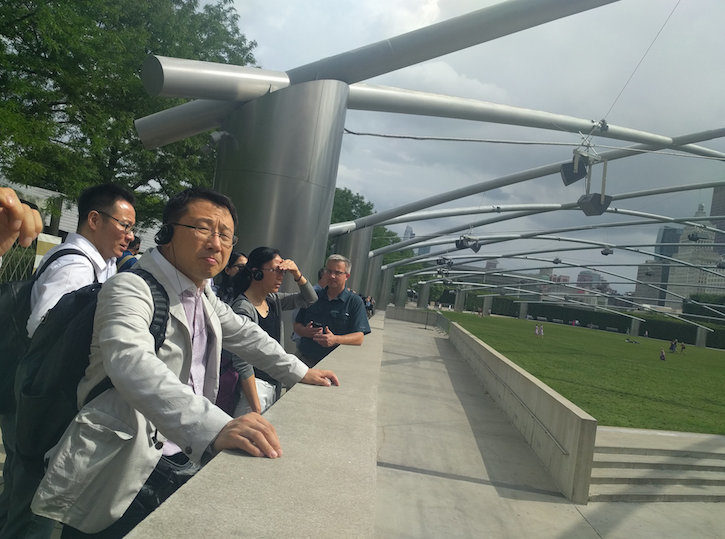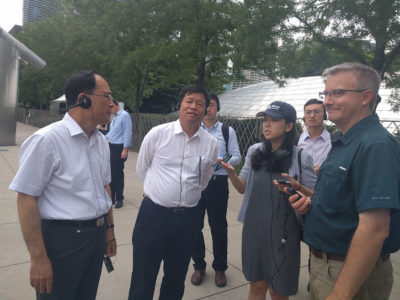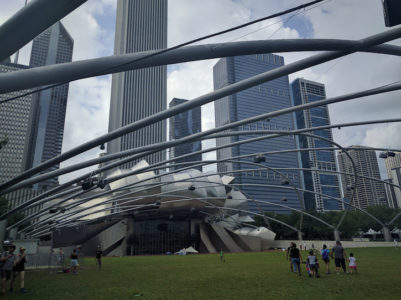By Claron Niu

On a recent overcast day in Chicago’s Millennium Park, a group of officials from the Chinese mega-city Tianjin crowded around to hear Scott Stewart, the executive director of the park’s Lurie Garden, talk about green and sustainable cities. Millennium Park is known for its public art and open green space, an unfurling green carpet fringed on three sides by skyscrapers and on the other side by Lake Michigan. Its success as both a tourist destination and a place for summer festivals and outdoor recreational space is a testament to Chicago’s commitment to greening itself and creating public spaces for the enjoyment of its residents.

But the Tianjin officials—mostly district leaders—were interested in a more pragmatic and pressing issue: how was it paid for, and what were the economic spillover benefits? Stewart’s answer: though the park cost an impressive $500 million to construct, it has generated more than $10 billion over 10 years in increased land values, new construction, tourist spending, and other miscellaneous revenue. Initial construction was mostly financed by private philanthropy, which lowered government costs.
The Chinese delegates were in the United States in July as participants of the Paulson Institute’s Mayors Training Program, which brings Chinese urban policymakers to the U.S. each year for a two-week study tour on sustainable cities and green growth. China has launched a nationwide urbanization plan—by 2020, 100 million migrant workers and other permanent urban residents should get city “hukou” (household registration)—as a way to modernize its economy, and the country’s mayors will play an important role in how its cities grow and take shape. The annual program is held in partnership with the University of Chicago Graham School and is supported by Hyatt Hotels Corp., Energy Foundation (EF) China, Motorola Solutions, John D. and Catherine T. MacArthur Foundation, Wanxiang America, and Skidmore, Owings, and Merrill.
After decades of breakneck growth, often at the expense of the environment, the Chinese government has made environmentally friendly growth and more sustainable cities a high political priority. The mayors are at the front lines of the country’s move away from a reliance on heavy industry and exports and instead to a low-carbon model driven by services. The new 13th Five Year Plan includes commitments to building an “eco-civilization” and specific targets for reducing energy consumption and cleaning up the environment. Mayors have been told that their promotions and compensation for the first time will depend not only on economic growth but also in part on their environmental achievements.

But a slowing Chinese economy and large municipal debt burdens have lowered maneuvering capacity for local governments to push grand new projects. And so during a series of seminars and panel discussions in Chicago, it was clear that the municipal officials not only were motivated to learn about sustainability—but were especially focused on financial how-tos. At Millennium Park, questions focused on issues such as finding ways to finance construction and maintenance costs of green space. Their answers may have come when the mayors heard from a panel featuring superstar architect Jeanne Gang, who spoke about the finances behind the Aqua tower, an undulating building she designed in downtown Chicago. According to Gang, the developer agreed to pay for the construction and continued upkeep of a six-acre park nearby, since the small green space helped raise nearby land values, increasing the market price for the tower’s apartments.
During a panel discussion with the CEO of the Chicago Park District, Michael Kelley, delegates asked about taxation and which governmental bodies were responsible for the parks. Kelley explained that the City of Chicago generates revenue by hosting special events, such as football games, music concerts, and festivals, on Park District property—instead of boosting admissions fees, which are kept low to ensure access to all citizens and their children.
What the mayors learned at Millennium Park, with its expansive green lawns and gleaming sculptures, is that such “non-commercial” projects may at first glance seem luxurious—but that they can help drive economic growth. Kelley’s ultimate point: parks are not vanity projects, nor do they have only abstract social effects such as public enjoyment. Their existence also generates cold, hard cash.


